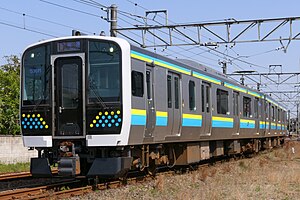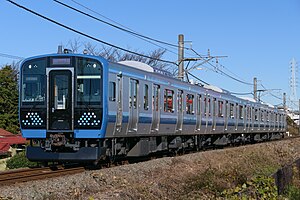E131 series – Wikipedia
From Wikipedia, the free encyclopedia
Japanese train type
| E131 series | |
|---|---|
 |
|
| Manufacturer | Japan Transport Engineering Company |
| Built at | Akiha-ku, Niigata |
| Family name | sustina |
| Replaced | 205 series, 209-2000/2100 series |
| Constructed | 2020−2022 |
| Entered service | 13 March 2021 |
| Number built | 117 vehicles (39 sets) |
| Number in service | 117 vehicles (39 sets) |
| Formation | 2–4 cars per trainset |
| Operator(s) | JR East |
| Line(s) served | Kashima Line, Narita Line, Nikkō Line, Sotobō Line, Uchibō Line, Sagami Line, Utsunomiya Line |
| Car body construction | Stainless steel |
| Car length | 19.57 m (64 ft 2 in) (end cars) 19.5 m (64 ft 0 in) (intermediate cars) 20 m (65 ft 7 in)(from coupler to coupler) |
| Width | 2.95 m (9 ft 8 in) |
| Height | 3.62 m (11 ft 11 in) (3.95 m (13 ft 0 in) with pantograph up) |
| Floor height | 1.13 m (3 ft 8 in) |
| Doors | 4 pairs per side |
| Maximum speed | 110 km/h (68 mph) |
| Traction system | Hitachi hybrid-SiC/IGBT–VVVF |
| Traction motors | MT83 150 kW (201 hp) 3-phase AC induction motor |
| Transmission | 7.07:1 (99:14) gear ratio |
| Electric system(s) | 1,500 V DC overhead catenary |
| Current collector(s) | Pantograph |
| Track gauge | 1,067 mm (3 ft 6 in) |
The E131 series (E131系) is a DC electric multiple unit (EMU) train type operated by the East Japan Railway Company (JR East). It began operations in the Chiba area on 13 March 2021, on the Sagami Line on 18 November 2021, and on the Nikkō Line and the Utsunomiya Line on 12 March 2022. The trains are equipped for driver-only operation (wanman (ワンマン, “one man”)).
The E131 series trains have stainless steel bodies.[1] They have LCD passenger information displays above the doors,[1] as well as wheelchair-accessible and stroller-accessible “free spaces” on all cars. As they are equipped for “wanman” driver-only operation, body-mounted cameras are utilized to monitor passengers boarding and alighting the train; these cameras are then fed to displays located in the driver’s cab.[1][2] They also feature semi-automatic doors, allowing passengers to operate the doors during driver-only operation.[1][2]
Internally, the trains are equipped with security cameras and emergency call switches.[1]
Some trains in each subseries are numbered -X80, as they have a slightly different equipment configuration due to the presence of track monitoring equipment.
-

LED destination board, displaying information in both Japanese and English (E131-0 series)
-

External security cameras (E131-0 series)
-

Internal passenger door buttons (E131-600 series)
-

Driver’s cab (E131-500 series)
Variants[edit]
History[edit]
The series and its scheduled introduction into the Sotobō Line (Kazusa-Ichinomiya Station – Awa-Kamogawa Station), Uchibō Line (Kisarazu Station – Awa-Kamogawa Station), and Kashima Line (Sawara Station – Kashimajingū Station) was announced on 5 May 2020.[3] It was the first all-new series introduced in the region in 51 years since the 113 series in the late 1960s;[4][5] the previous 211 series and 209 series were transferred from other lines. On 18 December 2020, it was further announced that the series would operate certain services in the Narita Line (between Narita Station and Katori Station) and Kashima Line (between Katori Station and Sawara Station).[6][7]
On 17 June 2021, JR East announced that a new subseries will be introduced on the Sagami Line (Chigasaki Station – Hashimoto Station) in fall 2021,[8] and another subseries will be introduced into the Nikkō Line (Utsunomiya Station – Nikkō Station) and the Utsunomiya Line (Oyama Station – Kuroiso Station) in Spring 2022.[9]
E131-0/-80 series[edit]
A total of 12 two-car sets were ordered and built.[10][11] Test runs began in July 2020, starting with the first two delivered sets R01 and R02.[12] The first ten sets (R01–R10) entered passenger service on 13 March 2021.[11][3]
The trains are painted in the Uchibo/Sotobo Line color scheme and formed as two-car sets with four doors per car.[10]
Lines served[edit]
The series serves the following sections of lines:[6]
Formations[edit]
As of 19 March 2021[update], 12 two-car sets (R01–R12) are based at Makuhari Rolling Stock Centre in Chiba Prefecture and formed with 1 motored (“M”) car and 1 trailer (“T”) car.[13][better source needed]
|
← Kashimajingū, Kazusa-Ichinomiya Narita, Kisarazu → |
||
| Designation | Mc | Tc’ |
|---|---|---|
| Numbering | KuMoHa E131-0/-80 | KuHa E130-0/-80 |
- The KuMoHa E131 car has a single-arm pantograph.[14]
- Both cars have an accessible/priority “free space”.[14]
- The KuHa E130 car has a universal design toilet.[14]
Interior[edit]
Passenger accommodation consists of a combination of longitudinal and transverse seating.[1] Priority seating and wheelchair- and stroller-accessible “free spaces” are provided in each car. KuHa E130 features a universal design toilet.
-

Passenger information display
-

Interior view. Transverse seating bays can be seen at the end.
-

Mixed longitudinal and transverse seating
-

-

Priority seating with wheelchair/stroller space
-

-

Onboard universal design toilet
Fleet details[edit]
The table below shows the details of each set.
| Set No. | Delivery date | Leading car | Trailing car |
|---|---|---|---|
| R01 | 21 July 2020[15] | KuMoHa E131-1 | KuHa E130-1 |
| R02 | KuMoHa E131-2 | KuHa E130-2 | |
| R03 | 28 August 2020[16] | KuMoHa E131-3 | KuHa E130-3 |
| R04 | KuMoHa E131-4 | KuHa E130-4 | |
| R05 | 10 October 2020[17] | KuMoHa E131-5 | KuHa E130-5 |
| R06 | KuMoHa E131-6 | KuHa E130-6 | |
| R07 | 26 November 2020[18] | KuMoHa E131-7 | KuHa E130-7 |
| R08 | KuMoHa E131-8 | KuHa E130-8 | |
| R09 | 12 February 2021[19] | KuMoHa E131-9 | KuHa E130-9 |
| R10 | KuMoHa E131-10 | KuHa E130-10 | |
| R11 | 2 March 2021[20] | KuMoHa E131-81 | KuHa E130-81 |
| R12 | 19 March 2021[21] | KuMoHa E131-82 | KuHa E130-82 |
- Sets R11[20] and R12 are fitted with track monitoring equipment.
E131-500/-580 series[edit]
| E131-500/-580 series | |
|---|---|

Set G-02 in November 2021 |
|

Interior (November 2021) |
|
| Replaced | 205-500 series |
| Constructed | 2021–2022 |
| Entered service | 18 November 2021 |
| Number built | 48 vehicles (12 sets) |
| Number in service | 48 vehicles (12 sets) |
| Formation | 4 cars per trainset |
| Fleet numbers | G-01 – G-12 |
| Operator(s) | JR East |
| Depot(s) | Kōzu |
| Line(s) served | Sagami Line |
| Train length | 80 m (262 ft 6 in) (including couplers) |
| Traction motors | 8 × 150 kW (201 hp) |
| Power output | 1.2 MW (1,609 hp) |
| UIC classification | Bo′Bo′+2′2′+Bo′Bo′+2′2′ |
A total of 12 four-car trains were built for the Sagami Line;[8] the first set (G-01) entered service on 18 November 2021.[22] It replaced the existing 205-500 series trains that have been in service since 1991.[8]
These trains were also used on through services between the Sagami Line and Yokohama Line during the morning and evening rush; these services ended on 11 March 2022.[23]
Lines served[edit]
The series serves the following sections of lines:[8]
Formations[edit]
As of 26 January 2022[update], twelve four-car sets (G-01–G-12) are based at Kōzu Depot in Kanagawa Prefecture and formed with 2 motored (“M”) cars and 2 trailer (“T”) cars.[24][better source needed] Sets G-11 and G-12 are fitted with track monitoring equipment.[25]
|
← Hachiōji, Hashimoto Chigasaki → |
||||
| Car No. | 4 | 3 | 2 | 1 |
|---|---|---|---|---|
| Designation | Mc | T | M | Tc’ |
| Numbering | KuMoHa E131-500/-580 | SaHa E131-500 | MoHa E130-500 | KuHa E130-500/-580 |
- Cars 2 and 4 each have a single-arm pantograph.[14]
- All cars have an accessible/priority “free space”.[14]
- Car 3 is designated as a mildly air-conditioned car.[14]
Interior[edit]
Passenger accommodation consists of longitudinal seating throughout.[14] Priority seating and wheelchair- and stroller-accessible “free spaces” are provided in each car.[14]
-

-

-

Priority seating with free space
-

LCD passenger information display
E131-600/-680 series[edit]
| E131-600/-680 series | |
|---|---|

E131-600 series set TN6 in March 2022 |
|

Interior (March 2022) |
|
| Replaced | 205-600 series |
| Constructed | 2021–2022 |
| Entered service | 12 March 2022 |
| Number built | 45 vehicles (15 sets) |
| Number in service | 45 vehicles (15 sets) |
| Formation | 3 cars per trainset |
| Fleet numbers | TN1–TN15 |
| Operator(s) | JR East |
| Depot(s) | Oyama |
| Line(s) served | Nikkō Line, Utsunomiya Line |
| Train length | 60 m (196 ft 10 in) (including couplers) |
| Traction motors | 6 × 150 kW (201 hp) |
| Power output | 900 kW (1,207 hp) |
| UIC classification | Bo′Bo′+2′Bo′+2′2′ |
A total of 15 three-car trains were built for the Nikkō Line and Utsunomiya Line.[9] The first fourteen sets (TN1–TN14) entered service on 12 March 2022.[26] It replaced the existing 205-600 series trains that have been in service since 2013.[9]
Lines served[edit]
The series serves the following sections of lines:[9]
Formations[edit]
As of 14 February 2022[update], 15 three-car sets (TN1–TN15) are based at Oyama Depot in Tochigi Prefecture and formed with 2 motored (“M”) cars and 1 trailer (“T”) car (the MoHa E131 car has one motorized bogie and one trailer bogie). Sets TN14 and TN15 are fitted with track monitoring equipment.[27][better source needed]
|
←Utsunomiya line:Kuroiso, Ujiie Utsunomiya, Oyama → ←Nikko Line :Utsunomiya Kanuma, Nikko → |
|||
| Designation | Mc | M1 | Tc’ |
|---|---|---|---|
| Numbering | KuMoHa E131-600/-680 | MoHa E131-600 | KuHa E130-600/-680[27] |
- The KuMoHa E131 car has two single-arm pantographs, while the MoHa E131 car has one.[14]
- All cars have an accessible/priority “free space”.[14]
- The KuHa E130 car has a universal design toilet.[14]
References[edit]
Recent Comments